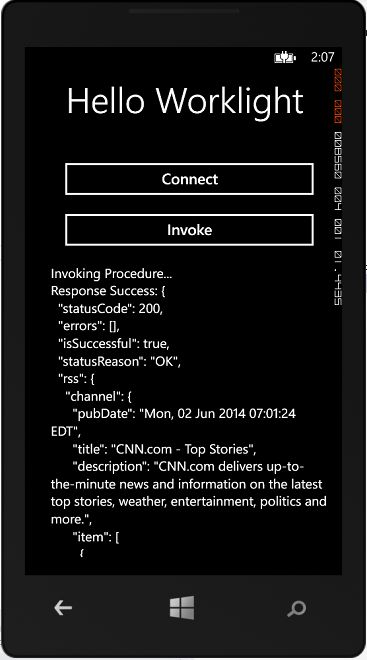Resource request from native Windows Phone 8 applications
improve this page | report issueOverview
To create and configure a Windows Phone 8 (Silverlight) native project, first follow the Configuring a native Windows Phone 8 application with the MobileFirst Platform SDK tutorial.
Initializing WLClient
WLClient client = WLClient.getInstance();
- To establish a connection to MobileFirst Server, use the
connectmethod by specifying theMyConnectResponseListenerclass instance as a parameter.
client.connect(new MyConnectResponseListener(this));The
WLClientinstance tries to connect to the MobileFirst Server instance according to the properties of thewlclient.propertiesfile.
After the connection is established, it invokes one of the methods of theMyConnectResponseListenerclass. - Specify that the
MyConnectResponseListenerclass implements theWLResponseListenerinterface.public class MyConnectResponseListener : WLResponseListenerThe
WLResponseListenerinterface defines two methods:public voidonSuccess (WLResponse response) { }public voidonFailure (WLFailResponse response) { }
- Use the previous methods to process connection success or connection failure.
Invoking an adapter procedure
After the connection is established with a MobileFirst Server instance, you can use the WLClient instance to invoke adapter procedures.
- Create a
WLProcedureInvocationDataobject with the adapter and procedure names. - Add the required parameters as an object array and set request options (for example: Invocation Context).
- Get the existing
WLClientinstance and use it to invoke an adapter procedure. - Specify the
MyInvokeListenerclass instance as a parameter.WLProcedureInvocationData invocationData = new WLProcedureInvocationData("RSSReader", "getFeed"); invocationData.setParameters(new Object[]{}); String myContextObject = "InvokingAdapterProceduresWP8"; WLRequestOptions options = new WLRequestOptions(); options.setInvocationContext(myContextObject); WLClient.getInstance().invokeProcedure(invocationData, new MyInvokeListener(this), options);
Receiving a procedure response
After the procedure invocation is completed, the WLClient instance calls one of the methods of the MyInvokeListener class.
As before, you must specify that the MyInvokeListener class implements the WLResponseListener interface.
using IBM.Worklight;
namespace InvokingAdapterProceduresWP8{
public class MyInvokeListener : WLResponseListener
{ }
{
The onSuccess and onFailure methods are invoked by the WLClient. The response object contains the response data. You can use its methods and properties to retrieve the required information.
public void onSuccess(WLResponse response)
{
WLProcedureInvocationResult invocationResponse = ((WLProcedureInvocationResult) response);
JObject items;
try
{
items = invocationResponse.getResponseJSON();
Deployment.Current.Dispatcher.BeginInvoke(() =>
{
myMainPage.AddTextToReceivedTextBlock("Response Success: " + items.ToString());
});
}
catch (JsonReaderException e)
{
Deployment.Current.Dispatcher.BeginInvoke(() =>
{
myMainPage.AddTextToReceivedTextBlock("JSONException : " + e.Message);
});
}
}
public void onFailure(WLFailResponse response)
{
Deployment.Current.Dispatcher.BeginInvoke(() =>
{
myMainPage.AddTextToReceivedTextBlock("Response failed: " + response.ToString());
});
}
Sample application
Click to download the MobileFirst project.
Click to download the Native project.
- The
InvokingAdapterProceduresproject contains a MobileFirst Native API to deploy to MobileFirst Server. - The
InvokingAdapterProceduresproject contains a native Windows Phone 8 application that uses a MobileFirst native API library to communicate with a MobileFirst Server instance.
Make sure to update the wlclient.properties file in NativeWP8Invoking with the relevant server settings.

Inclusive terminology note: The Mobile First Platform team is making changes to support the IBM® initiative to replace racially biased and other discriminatory language in our code and content with more inclusive language. While IBM values the use of inclusive language, terms that are outside of IBM's direct influence are sometimes required for the sake of maintaining user understanding. As other industry leaders join IBM in embracing the use of inclusive language, IBM will continue to update the documentation to reflect those changes.